Table of Contents
- The 85 Ghats of Banaras
- 1. Assi Ghat
- 2. Ganga Mahal Ghat
- 3. Riva (Rewan) Ghat
- 4. Tulsi Ghat
- 5. Bhadaini Ghat
- 6. Janaki Ghat
- 7. Anandamayi (Mata Anandami) Ghat
- 8. Vachcharaj Ghat
- 9. Jain Ghat
- 10. Nishadraj (Nishad) Ghat
- 11. Prabhu Ghat
- 12. Panchkota Ghat
- 13. Chet Singh Ghat
- 14. Niranjani Ghat
- 15. Maha Nirvani Ghat
- 16. Shivala Ghat
- 17. Gularia Ghat
- 18. Dandi Ghat
- 19. Hanuman Ghat
- 20. Prachina (Old Hanuman) Ghat
- 21. Karnataka State Ghat
- 22. Harishchandra Ghat
- 23. Lali Ghat
- 24. Vijayanagaram Ghat
- 25. Kedar Ghat
- 26. Chauki (Coawki) Ghat
- 27. Ksemesvara (Somesvara) Ghat
- 28. Manasarovara Ghat
- 29. Narada Ghat
- 30. Raja Ghat
- 31. Khori Ghat
- 32. Pande (Pandey) Ghat
- 33. Sarvesvara Ghat
- 34. Digpatia Ghat
- 35. Chausatti Ghat
- 36. Rana Mahal Ghat
- 37. Darbhanga Ghat
- 38. Munsi Ghat
- 39. Ahilyabai Ghat
- 40. Sitala Ghat
- 41. Dashashwamedh Ghat
- 42. Prayag Ghat
- 43. Rajendra Prasad Ghat
- 44. Man Mandir Ghat
- 45. Tripurabhairavi Ghat
- 46. Mira Ghat
- 47. Phuta (Naya) Ghat
- 48. Nepali Ghat
- 49. Lalita Ghat
- 50. Bauli Ghat
- 51. Jalashayi Ghat
- 52. Khirki Ghat
- 53. Manikarnika Ghat
- 54. Bajirao Ghat
- 55. Scindia Ghat
- 56. Sankata Ghat
- 57. Ganga Mahal Ghat – 2
- 58. Bhonsale Ghat
- 59. Naya Ghat
- 60. Ganesha Ghat
- 61. Mehta Ghat
- 62. Ram Ghat
- 63. Jatara Ghat
- 64. Raja Gwalior Ghat
- 65. Mangala Gauri (Bala or Lakshmanbala) Ghat
- 66. Venu Madhava (Bindu Madhava) Ghat
- 67. Panchganga Ghat
- 68. Durga Ghat
- 69. Brahma Ghat
- 70. Bundi Parakota Ghat
- 71. Shitala Ghat
- 72. Lala Ghat
- 73. Hanuman Garhi Ghat
- 74. Gai (Gaya) Ghat
- 75. Badri Narayan Ghat
- 76. Trilochan Ghat
- 77. Gola Ghat
- 78. Nandikeshvara (Nandu) Ghat
- 79. Sakka Ghat
- 80. Telianala Ghat
- 81. Naya (Phuta) Ghat
- 82. Prahlad Ghat
- 83. Rani Ghat
- 84. Raja Ghat
- 85. Adi Keshava Ghat
The 85 Ghats of Banaras
1. Assi Ghat
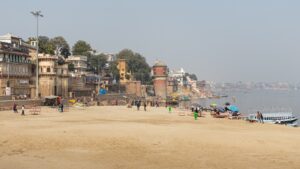
Originally much larger, Assi Ghat traditionally marks the southern end of the traditional city, being the last of the major bathing ghats to retain its clay bank. In the 19th century, it was split into what is now Ganga Mahal, Rewan, Tulsi and Bhadaini ghats.
The Assi Ghat is a renowned spiritual site, with the Panchatirth and Haridwar pilgrimages requiring a pilgrimage there. Taking a holy bath in the Assi Ghat is considered to be deeply auspicious, as ancient texts have described the river that flows there as a tributary of the Ganga. Near the banks of the river lies an open-air temple beneath a pipal tree.
2. Ganga Mahal Ghat

The Ganga Mahal Ghat is named after the erstwhile palace of a maharaja of Banaras, situated at the northern edge of Assi Ghat, dating back to the early twentieth century.
3. Riva (Rewan) Ghat

Originally known as Lala Mishir Ghat, this site was named after a palace built by the family priest of King Ranjit of Punjab. In 1879, Maharaja Rivan acquired the palace and ghat, renaming them both to Riva. Today, the former palace is a hostel accommodating students studying music.
4. Tulsi Ghat

The renowned Tulsi Ghat is named after the illustrious poet Tulsidas (1547-1622 A.D.), who is renowned for authoring Ramcharitmanas, a translation of the Sanskrit epic Ramayana. Tulsidas established a monastery, Hanuman temple, and Askaha in the vicinity of the ghat. Initially, the ghat was referred to as Lolark Ghat, on account of the Lolark Kund that stands nearby.
5. Bhadaini Ghat

The iconic water tower of the sprawling pumping station serves as a landmark for the city. It is the main supplier of water to the entire locale, and its purpose is strictly utilitarian in nature.
6. Janaki Ghat

Originally referred to as Nagamber Ghat, the existing ghat was constructed in 1870 by Maharani Kunwar of Sursand (in Bihar). Janaki is an alternative name for Sita, the wife of Ram.
7. Anandamayi (Mata Anandami) Ghat

Anandamayi is a name derived from the Sanskrit term for ‘bliss permeated’, and is famously attributed to the woman saint who founded an ashram for girls in 1944. Previously known as Imalia Ghat, the ghat was bought from the British by Anandamayi and was renowned for her capacity to heal a variety of physical and mental ailments.
8. Vachcharaj Ghat

Vachcharaj Ghat, constructed in the late 18th century, is named after a Jain banker who significantly contributed to the establishment of Banaras as a hub of commerce. This ghat is also said to be the birthplace of Suparshvanath, the seventh Tirthankara, and it is now a residential area for much of the Jain population of the city.
9. Jain Ghat

Originally, Vachcharaj Ghat included this area, but it was declared its own Ghat in 1931. The southern end is principally utilized for bathing, while the northern end is populated by members of the Mallaha (boatman) community.
10. Nishadraj (Nishad) Ghat

Originally, this Ghat formed part of the Prabhu Ghat situated to the north, until it was divided in the beginning of the 20th century. The Ghat is named after the legendary leader of the boatmen who assisted Rama, Sita and Lakshmana during their crossing of the Sarayu River, as narrated in the Ramayana. Today, a significant number of fishermen and boatmen may be found here.
11. Prabhu Ghat

Prabhu Ghat, constructed in the early 20th century, was named after Maharaja Prabhu Narayan Singh who reigned over Banaras in the period 1889-1931. This area is well-known for its laundry service and is also inhabited by numerous boatmen families.
12. Panchkota Ghat

In the late 19th century, the King of Panchakola (Bengal) erected the Panchkota Ghat, with a series of slender staircases leading to a palatial edifice which houses two temples.
13. Chet Singh Ghat

The grand palace of Maharaja Chet Singh, the illegitimate son of the first Maharaja of Banaras, Balwant Singh, looms over this ghat. Chet Singh was able to gain the throne by outmaneuvering Mahip Narayan Singh and providing a bribe to the Nawab of Awadh.
In 1781, the transition of power from Chet Singh to Governor General Warren Hastings resulted in a fierce battle here. With the conflict raging outside the palace, Chet Singh made his escape by scaling a window and using a makeshift rope of unraveled turbans to lower himself down to the ghat below.
14. Niranjani Ghat

In 1897, an Niranjani Akhara was founded on the site previously occupied by Chet Singh Ghat, a holy site located along the banks of the River Ganges near Varanasi, India. It was established to provide shelter and spiritual guidance to pilgrims who visited the site for spiritual healing and renewal. The Akhara soon became a place of refuge for many of the local villagers as well, who sought respite from the oppressive conditions of their everyday lives.
Over time, the Akhara has become an important place of worship and pilgrimage, with thousands of devotees coming each year to offer prayers and receive blessings from the Akhara’s many religious leaders. As the years have gone by, the Akh
15. Maha Nirvani Ghat

This Ghat, believed to have been the location where Lord Buddha took a bath, was the residence of Acharya Kapil Muni of Sankhya philosophy fame in the 7th century A.D., and is named in honor of the Mahanirvani sect of Naga Saints. It is also noteworthy that the former home of Mother Teresa is located nearby.
16. Shivala Ghat

The area around Shivala, meaning ‘abode of Shiva’, is dominated by a colossal building constructed by Nepali King Sanjay Vikram Shah. The area is also home to a Shiva temple overlooking the ghat and a large South Indian community that has inhabited Banaras for the past two centuries for both business and religious purposes.
17. Gularia Ghat

This Ghat, one of the smallest along the mighty Ganges, was named after a large Gular tree that once grew in this area. Local legend has it that the tree was planted by a hermit who had taken up residence in the area many years ago. It is said that he meditated beneath the Gular tree for hours on end, and was an important part of the community. After his death, the locals began to refer to the area as the Gular Ghat in honour of the hermit. Today, the Gular Ghat is a popular destination for tourists who flock to the area to admire its beauty and serenity.
18. Dandi Ghat

The Lalooji Agarwal-renovated ghat is a stunning piece of architecture that stands out among the many ghats in the region. It is named after the Dandi ascetics, who are noted for their signature staffs. The ascetics are said to have been living in the area since the 12th century and were known for their discipline and devotion to their faith.
The monastery they built in close proximity to the ghat is a beautiful sight and is a testament to their dedication. Inside the monastery, one can find centuries-old scriptures and artifacts that pay homage to the ascetics’ faith. The monastery also serves as a place of contemplation and spiritual renewal for those who visit. The Dandi ascetics have
19. Hanuman Ghat

Previously known as Ramesvaram Ghat, Hanuman Ghat was given its current name due to the temple erected here in the 18th century by the renowned poet Tulsidas. This ghat is further distinguished by the temple of Ruru, the canine incarnation of Bhairav.
20. Prachina (Old Hanuman) Ghat

This Ghat is renowned as the birthplace of saint Vallabha (1479-1531 A.D.), who developed a philosophy that sparked a revival of Krishna bhakti. The temple of Rama is composed of five Shiva Lingams named after Rama (Ramesvara), his two brothers (Laksmansevara and Bharatsvarar), and his wife (Sitesv).
21. Karnataka State Ghat

Constructed in 1910 by the then-southern State of Mysore (now Karnataka), the Juna Order of Ascetics have a monastery and akhara located at this site. The Government of Karnataka operates a guesthouse here, which is open to all, though mainly used by visitors from Karnataka.
22. Harishchandra Ghat

Adi Manikarnika, alternatively referred to, is reckoned to be one of the oldest and two cremation ghats of the city. It is believed to be named after the legendary King who once was known to have worked in the cremation grounds in Kashi.
In 1987, an electric crematorium was introduced in this area, yet the majority of cremations continue to be carried out using traditional wooden pyres. In 1740, the religious guru Narayana Diksit renovated the ghat.
23. Lali Ghat

Constructed in 1778 by the ruler of Banaras, Manikarnika Ghat is a small but important ghat on the Ganges River. It is believed to be the site of Lord Shiva’s earring and is believed to be the gateway to the afterlife. Presided over by laundry workers, the ghat is the site of cremations, rituals and other sacred activities, and is an integral part of the culture of Banaras. Many devotees come here to take a dip in the holy waters as a sign of respect and as a way to cleanse their souls. It is said that even a single drop of water from the ghat has the power to grant freedom from the cycle of reincarnation.
24. Vijayanagaram Ghat

In 1890, the Vijayanagaram State of South India undertook a renovation of the ghat, which is now watched over by the Svami Karapatri Asrama and features shrines to Nilakantha and Nispapesvara.
25. Kedar Ghat
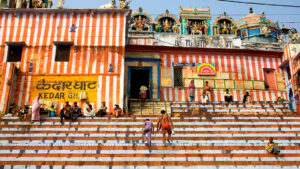
Kedar Ghat has a prominent portrayal in the Kedara Khanda of the Skanda Purana and is renowned for the Kedareshvara Linga, one of the fourteen lingas of considerable importance, as acknowledged by ancient scripture.
The ancient temple of Kedar is situated in the Himalayas along the banks of the Ganges, as described in Puranic texts. It is said that Lord Shiva originally established the linga there before constructing the temple at Kashi. Some experts believe that the Kedar temple may have been in existence even before the Vishwanath Temple.
During the late 16th century, Kumarasvami, a devotee of Dattatreya, established a monastery connected to the Kedaresvar temple. An inscription from the Gahadavala period, dated around 1100 A.D., made reference to a Svapnesvara Ghat nearby; unfortunately the exact location of this is currently unknown.
26. Chauki (Coawki) Ghat

Constructed in 1790, popularly referred to as the Buddhist Ghat, this site is renowned for its monumental pipala (ficus religiosa) tree situated at the summit of the stairs beneath which lies an array of stone nagas.
In proximity to the tree is the Rukmangesvara shrine, with the Naga Kupa (or “Snake Well”) situated a short distance away. The presence of a washermen community residing near the ghat has resulted in the platforms, iron-railings, and embankments being utilized for drying clothes.
27. Ksemesvara (Somesvara) Ghat

Previously referred to as Nala Ghat, the ghat existing today was constructed in the early 18th century. In 1962, devotees of Kumarasvami constructed a monastery here, and simultaneously established shrines of Kesemesvara and Ksemaka Gana. Presently, the neighbourhood is mainly inhabited by Bengali residents.
28. Manasarovara Ghat

This ghat, which was originally constructed by Raja Man Singh of Amber in 1585, and restored in 1805, is named in reference to the hallowed Manasarovar Lake in Tibet.
29. Narada Ghat

Originally known as Kuvai Ghat, Narada Ghat is named after the renowned sage Narada, who is typically portrayed carrying the one-stringed Ektara instrument. It was built by Dattatreya Svami, the abbot of a monastery, in the year 1788.
30. Raja Ghat

This ghat, formerly known as Amrita Rao Ghat, was constructed by Maratha chief Gajirao Balaji in 1720. It was gradually reconstructed with stone slabs between 1780 and 1807. Even today, it continues to be part of the Amritrao Peshwa Annapurna Trust.
31. Khori Ghat

Situated in the city of Varanasi, this Ghat was refurbished in the late 19th century by Kavindra Narayana Singh and is popularly referred to as Ganga Mahala Ghat. Boasting five temples overlooking the majestic Ganga river, it is a landmark of the city.
32. Pande (Pandey) Ghat

This ghat, which was christened after the renowned wrestler from Varanasi, Babua Pande, was built atop the steps here by him and his akhara.
33. Sarvesvara Ghat

The construction of this small ghat was commissioned by Mathura Pandey in the late eighteenth century.
34. Digpatia Ghat

The stately palace, now known as Kashi Ashram, situated at the front of this ghat, was commissioned in 1830 by the king of Digpatia in Bengal.
35. Chausatti Ghat

The ghat, named for the temple of 64 goddesses which overlooks it, was the residence of renowned Sanskrit scholar Madhusudana Sarsvati (1540-1623). The temple was later restored by the King of Udaipur (Rajasthan), circa 1670.
36. Rana Mahal Ghat

As part of the northern addition to Chausathi Ghat, Rana Mahal Ghat was constructed by the King of Udaipur (Rajasthan) in 1670. Atop the ghat stands a temple devoted to the deity Vakratunda Vinayaka.
37. Darbhanga Ghat

The Darbhanga Palace, an impressive edifice constructed by the King of Darbhanga (Bihar) in 1915, looms over this ghat, accompanied by a nearby Shiva temple. At the summit is a shrine dedicated to Kukutesvara.
38. Munsi Ghat
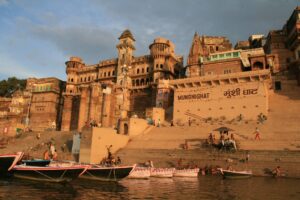
In 1912, Sridhar Narayan Munsi, the finance minister of Nagpur, constructed Munsi Ghat. This extension of Darbhanga Ghat was named in his honour after his demise in 1924.
39. Ahilyabai Ghat

The Kevelyagiri Ghat underwent substantial renovations in 1778 under the patronage of Indore’s Queen Ahilyabai Holkar. Her commitment to developing religious infrastructure in Banaras was evidenced by the construction of the Amethy Temple on Manikarnika Ghat and the renowned Vishwanath Temple. As a result of her contributions, this ghat was formally renamed in her honour.
40. Sitala Ghat

In 1740, the renowned Narayana Diksit refurbished Sitala Ghat, which is a northern extension of Dashashwamdh Ghat and is named after the iconic Sitala Temple located there.
41. Dashashwamedh Ghat

Positioned in the center of the series of ghats located along the Ganges River, Dashashwamdh Ghat is widely noted as the most active of all the ghats and is commonly referred to by visitors as “the primary ghat”.
It is said that at the site of Divodasa, Lord Brahma conducted a ritual of ten-horse sacrifice (dasa-asvamedha). During the day, priests provide different ceremonies and rites for pilgrims, and in the evening, a daily aarti ritual is conducted.
This ghat holds a great deal of historical significance for its connection to various pilgrimage routes. In the 18th century, the southern part of the ghat was refurbished by Balaji Bajirao Peshwa in 1740, with additional modifications being made by Ahilyabai Holkar of lndore in 1774.
42. Prayag Ghat

The Dashashwamdh Ghat separates Allahabad, another renowned holy city, from Banaras, located 80 miles to the west. At the confluence of the Ganga, Yamuna, and Saraswati rivers, it is a significant pilgrimage site.
It is widely accepted that the performance of rituals and bathing in this sacred area provide the same spiritual benefit as at Prayaga. The ghat was refurbished by the Queen of Digpatia State in the 19th century.
43. Rajendra Prasad Ghat

[ Still considered an extension of Dashashwamdh Ghat, it was once known as Ghoda Ghat (Horse Ghat) due to a stone statue of a horse that once stood here recognising the ten horse sacrifice.
In the latter part of the 19th century, the statue was relocated to the Sankatmochana temple. To honour the first President of India, who had been in office from 1950 to 1962, the ghat was renamed in 1979.
44. Man Mandir Ghat

The Somesvara Ghat was rechristened to the Man Mandir Palace in 1585, when the Rajput king of Amber, Man Singh, constructed his palace, featuring an astronomical observatory atop its roof.
45. Tripurabhairavi Ghat

This ghat is named in honour of the Tripura Bhairavi Shrine, a female consort of Tripuresvara whose effigy is also situated there. In the late 18th century, it was restored by the King of Banaras.
46. Mira Ghat

In 1735, Mira Rustam Ali, a celebrated tax collector in the city, converted the two ancient sites of Jarasandhesvara and Vrdhaditya into the existing ghat. He actively took part in the customary festivities of Banaras and is still remembered in certain regional folk songs during festivities such as Holi or Chaiti.
The Dharmesa temple is closely linked to the myth of Yama, the Lord of Death, who is believed to preside over the fate of the dead worldwide, with the exception of Kashi. In 1956, Svami Karapatri-Ji, a local Brahmin, established a new Vishwanath Temple in the area in order to serve the needs of the lower caste community.
47. Phuta (Naya) Ghat

Previously referred to as Yajnesvara Ghat, Phuta has been coined to mean “broken”, though the reason for its re-naming is unclear. In the mid 19th century, Svami Mahesvarananda undertook a renovation of the site.
48. Nepali Ghat

The Gorkha dynasty constructed the iconic Nepalese Temple in 1902, creating a distinct Nepalese-dominated atmosphere. E.B. Havell observed the ghat in 1841.
Nestled within a stone embankment, and becoming entirely inundated by the Ganges during the monsoon season, is a picturesque sanctuary devoted to Ganga, the goddess of the river, which is symbolized by a female figure perched atop a crocodile.
A staircase leads to the Nepalese temple, a picturesque building partially obscured by majestic tamarind and pippal trees. Constructed mostly from wood and bricks, its double-storied roof with large overhanging eaves upheld by brackets is a noteworthy feature of Nepalese architecture.
49. Lalita Ghat
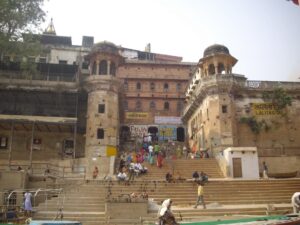
The city is renowned for its two iconic shrines, one dedicated to Vishnu known as Ganga Kashev, and the other to Ganga, referred to as Bhagirathi Devi. Additionally, a shrine of Lalita Devi is located in the area, and it is believed that seeing her grants the same merits as circumambulating the entire world.
50. Bauli Ghat

This ghat, previously known as Raja Rajesvari Ghat and currently referred to as Umaragiri and Amroha Ghat, is believed to have been constructed during the early 19th century by Babu Kasheva Deva, a wealthy merchant from Banaras.
51. Jalashayi Ghat

Jalashayi, a ritual involving the immersion of a deceased individual in water prior to their cremation, indicates that this ghat was perhaps previously used for this purpose prior to the cremation occurring at Manikarnika Ghat. The ghat and its associated structures, therefore, likely have a deep historical significance.
52. Khirki Ghat

The term “Khirki” translates to “windows”, which may suggest that it was a place from which the cremations taking place at Manikarnika Ghat could be observed by mourners and attendants. Five sati shrines are extant here, in addition to a pilgrim rest house built in 1940 by Baldeo Dasa Birla.
53. Manikarnika Ghat

Situated in Varanasi, Manikarnika Ghat is renowned for its association with cremations, dating back thousands of years. Notably, it was the first ghat to be renovated in stone, with epigraphic references from the Gupta period beginning in the 4th century A.D. For further information, please refer to my separate blog post.
54. Bajirao Ghat

In 1735, Bajirao Pesava was the architect of this ghat and the adjacent palace. Nearby is the highly popular and widely photographed Ratneshwar Mahadev Temple, a staple in the city of Banaras.
The region has been plagued by landslides over the centuries, necessitating repeat repairs and reconstructions by Queen Baijabai of Gwalior in the 1830s. This ghat was formerly known as Dattatreya Ghat in reference to the nearby Dattatreyesvara temple.
55. Scindia Ghat

Formerly known as Viresvara Ghat, named after the temple located in the vicinity of the Ganges, the ghat was constructed by Ahilabai Holker of Indore in 1780. Over the following years, the site has been subject to a number of refurbishments and remodelings, including those performed by Queen Baijabai in 1829 and Daulatarao Scindhia in 1937.
56. Sankata Ghat

Originally known as Yameshvara Ghat, Sankaha Ghat was built by the King of Baroda (Gujarat) in the late 18th century. Subsequently, in 1825, Beniram Pandit’s widow, affectionately known as “Panditain,” and her nephews renovated the ghat and constructed a temple of Sankata Devi.
57. Ganga Mahal Ghat – 2

The second Ghats of the same name in Varanasi, an exquisite palace, houses a temple dedicated to Krishna and Radha, built in 1865 by Queen Tarabai Raje Shinde, a Scindhia ruler from Gwalior. Originally constructed in the early 19th century by a monarch of Gwalior, this Ghats was later refurbished by…
58. Bhonsale Ghat

The Bhonsale Palace, constructed by the Maratha rulers of Nagpur in the late eighteenth century, stands prominently as one of the most stunning edifices to adorn the banks of the Ganga in Banaras. This stately palace reflects a remarkable blend of elegance and power, its captivating grandeur rising from the ghat to an impressive height.
This palace appears to be inspired by Chet Singh Palace to the south, with its roof housing two grand temples dedicated to Shiva and Vishnu. Close to the palace are venerated shrines of Yamesvara and Yamaditya.
59. Naya Ghat

Constructed by Maratha ruler Peshwa Amrit Rao, this ghat was dedicated to Lord Ganesha. “Naya” translates to ‘new’, and it served as one of the primary quays of the city. According to Prinsep’s map of 1822, this ghat was referred to as Gularia Ghat. In 1960, it underwent some repairs.
60. Ganesha Ghat

Agisvara Ghat, now known as Naya Ghat, underwent a period of renovation between 1761 and 1772, initiated by Madhorao Pesava. This ghat is renowned for its temple dedicated to the deity Ganesha.
61. Mehta Ghat

Established in 1962, Metha Ghat is an extension of Naya and Ganesha Ghat and is derived from the name of the nearby V.S. Mehta hospital.
62. Ram Ghat

The Ram Ghat is a renowned bathing area renowned for its proximity to the small Ram temple and the illustrious Sanga Veda School.
63. Jatara Ghat

In 1766, Madhorao Pesava undertook a revamping of the ghats along the Ganga and among the improvements made was the construction of the Jatara Ghat.
64. Raja Gwalior Ghat

Madhorao Pesava also constructed Jatara and Raja Gwalior Ghat in 1766, and despite lacking any distinct architectural separation, the two are often considered a single entity.
65. Mangala Gauri (Bala or Lakshmanbala) Ghat

Constructed by Bajirao Peshwa in 1735, the ghat underwent a renovation by Lakmana Bala of Gwalior in 1807 which has caused a variety of different names for the ghat. Situated above the ghat is a dilapidated temple which originally belonged to the Mathara Peshwas and was later transferred to the Schindia rulers of G.
66. Venu Madhava (Bindu Madhava) Ghat

Widely seen as the lower end of Panchganga Ghat, Venimadhava Ghat takes its moniker from the temple on the premises, which may have its origins in the 10th century. By 1496, the Bindu Madhava temple had been reduced to rubble, though it was reconstructed by the Maharaja of Amber in 1585.
Aurangzeb subsequently demolished the temple and constructed the Alamgir Mosque on its ruined foundations. Bindu Madhava was then re-erected a short distance away from the mosque.
67. Panchganga Ghat

Panchganga Ghat, located in the holy city of Banaras, is thought to be the convergence of five rivers/streams: the Ganga, Yamuna, Sarasvati, Kirana, and Dhupapapa – though only the mighty Ganga remains visible today.
The stone ghat was initially constructed by Raghunatha Tandan, the Finance Secretary of Mughal King Akbar, and was later renovated by Bajirao Pesava in 1735, followed by Sripatirao Pesava in 1775.
A multitude of three-sided shrines and cubicles facing the Ganges River offer spaces for yogis and meditators. Some of these compartments contain a linga or image, while others are vacant. In the mid-1850s, Matthew Atmore Sherring conducted research in Varanasi and described these cubicles.
The ghat is expansive and deep, with a remarkable degree of fortitude. Its steps and towers are entirely constructed of stone and, due to the sheer quantity of them, can accommodate a large number of devotees and bathers. The towers are low and hollow, and are utilized as places of worship and sanctuaries. Each one is home to several godlike figures.
An uninformed onlooker would be unaware of the presence of idols, and perhaps not consider that the pathway was atop a sequence of sacred sites, and over a multitude of deities. To comprehend the offense taking place, one would need to descend a few steps.
68. Durga Ghat

Prior to his demise in the mid-18th century, Narayana Diksit, a guru of the Pesavas, acquired land from local fishermen and constructed two ghats: Durga Ghat and Brahma Ghat.
Prior to 1800, Nana Phadanavisa, also known as Nana Fadnavis, undertook renovations and constructed an impressive mansion with a view of the ghat referred to as Phadanavisa Wada. Nana Phadanavisa served as Prime Minister of Pune, and is credited with a number of construction projects, particularly the substantial alterations made to Loha.
69. Brahma Ghat

Constructed simultaneously with Durga Ghat to the south, the Kasi Matha Sansthana monastery is situated atop the ghat.
70. Bundi Parakota Ghat

Originally referred to as Raja Mandira Ghat, this ghat was constructed in 1580 by Bundi’s King, Raja Surajana Hada. It has since gained fame for its impressive, large-scale murals applied to the walls, offering captivating sight from a distance.
71. Shitala Ghat

Continuing on from Bundi Parakota Ghat, Raja Surajana Hada constructed this ghat in 1580. It was named after the deity of smallpox, whose primary temple can be found at Dashashwamedh Ghat.
72. Lala Ghat
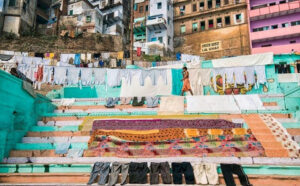
In the early 1800s, Lala Ghat was constructed by a wealthy merchant from Banaras and later named in his honour. In 1935, Baldeo Das Birla built a small sub-ghat, referred to as Gopi Givinda Ghat, and also erected a rest house for pilgrims.
73. Hanuman Garhi Ghat

This ghat, located in Ayodya – the birthplace of Lord Rama, and representing the renowned Hanumangarhi site, is thought to have been established in the late 19th century. Here, visitors can find a wrestling arena (Ganga Akhara) and a memorial stone erected in honour of a Sati.
74. Gai (Gaya) Ghat
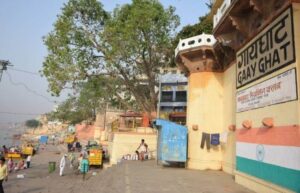
During the 12th century, Gai Ghat was seen as the southern border of Banaras, with the origin of Kashi beginning further north at Rajghat, where archaeological ruins can still be seen today. In the early 19th century, Balabai Shitole of Gwalior renovated Gai Ghat.
75. Badri Narayan Ghat

The ghat formerly referred to as Mahatha/Matha ghat was renovated by Balabai of Gwalior in the early 19th century and has since been renamed after the temple of Badri Narayan in the Himalayas.
76. Trilochan Ghat

This ghat, named after the Trilochan Temple, dedicated to the three-eyed Shiva, was a renowned venue for ceremonies and bathing during the 12th century Gahadavala rule. Prior to 1750, it was refurbished by Narayana Dixsit, and again in 1795 by Nathu Bala of Pune (Maharastra).
77. Gola Ghat

Gola Ghat is a historic ferry point that dates back to the 12th century, and derives its name from the numerous granaries that were situated here. Its significance decreased significantly after the building of the Malviya Bridge in 1887.
78. Nandikeshvara (Nandu) Ghat
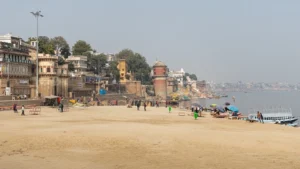
Constructed in the early 1900s by inhabitants of the surrounding area, an Akhara bearing the same name is also present here.
79. Sakka Ghat

The ghat, which was first recorded in the late 18th century, is primarily inhabited by washermen.
80. Telianala Ghat

This ghat, first attested in the late 18th century, has gained notoriety for Hiranyagarbha, an ancient sacred location. It bears the name of the Teli caste, who established themselves here centuries ago, due to their oil pressing tradition.
81. Naya (Phuta) Ghat

Originally known as Phuta Ghat and a place of reverence in the past, the area was abandoned in the 18th century before being renamed after subsequent renovations. Narsingh Jaipala Chainput-Bhabhua of Bihar undertook additional renovations in 1940.
82. Prahlad Ghat

Commemorating Prahlad, a renowned figure in ancient literature renowned for his piousness to Vishnu, references to the said ghat can be traced to Ghadavala inscriptions from the 12th century. Notably, the ghat was significantly larger before it was split in 1937 with the erection of the Nisada Ghat in the centre.
This region is home to a number of shrines, including Prahaladesvara, Prahalada Kesava, Vidara Narsimha, and Varada and Picindala Vinayakas to the south and Mahisasura Tirtha, Svaralingesvara, Yajna Varaha and Sivaduti Devi to the north.
83. Rani Ghat

Rani Ghat holds no religious importance and is one of the least popular ghats in Banaras. In 1937 Muniya Sahiba, a queen of Lucknow, built a grand house on the ghat and gradually people started calling it Rani Ghat.
In 1988, the government underwent a major refurbishment of Rani Ghat, which has since seen a steady rise in popularity. This location recently gained considerable media attention when Bollywood actor Sanjay Dutt conducted the last rites of his father, the veteran actor Sunil Dutt, here.
84. Raja Ghat

Prior to the inauguration of the Malviya Bridge in 1887, Raja Ghat was the most well-known and busiest ferry ghat in Varanasi. Records from the 11th century Gahadava inscriptions refer to the Raja Ghat area, although the region has a history that stretches back much further.
Visitors can still explore the archaeological traces of the original Kashi, believed to have been built along the banks of the Ganga, situated past the Malviya Bridge, which was named after the founder of the Banaras Hindu University.
85. Adi Keshava Ghat

At Vedesvara Ghat, which is thought to be the original home of Lord Vishnu and a popular pilgrimage site for the Gahadavala kings, visitors can experience a more rustic atmosphere. To learn more about this ghat, please refer to my blog post.
Follow Banaras Trip For More Banarasi Content.

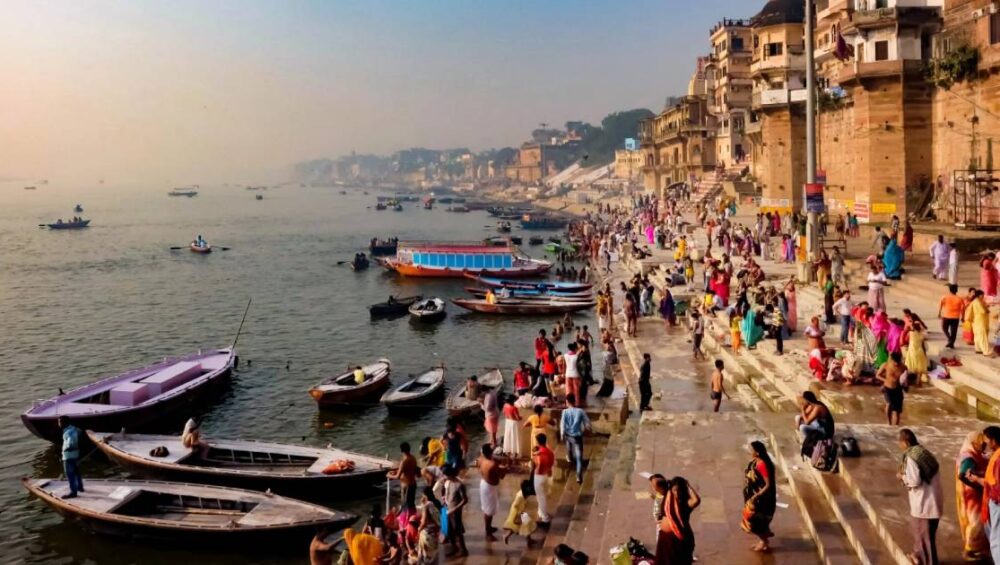











1 Comment
Thanks.